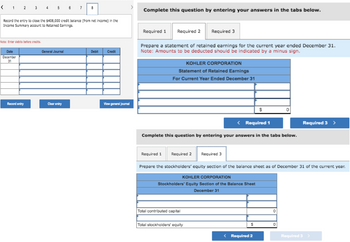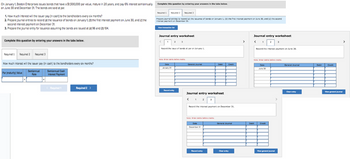
FINANCIAL ACCOUNTING
10th Edition
ISBN: 9781259964947
Author: Libby
Publisher: MCG
expand_more
expand_more
format_list_bulleted
Concept explainers
Topic Video
Question

Transcribed Image Text:< 1 2 3 4 5 6
Record the entry to close the $408,000 credit balance (from net income) in the
Income Summary account to Retained Earnings.
Note: Enter debits before credits.
Date
December
31
Record entry
General Journal
7 8
Clear entry
Debit
Credit
View general Journal
Complete this question by entering your answers in the tabs below.
Required 1
Prepare a statement of retained earnings for the current year ended December 31.
Note: Amounts to be deducted should be indicated by a minus sign.
Required 2
Required 1
KOHLER CORPORATION
Statement of Retained Earnings
For Current Year Ended December 31
< Required 1
Complete this question by entering your answers in the tabs below.
Required 2
Required 3
Total contributed capital
Total stockholders' equity
Required 3
Prepare the stockholders' equity section of the balance sheet as of December 31 of the current year.
KOHLER CORPORATION
Stockholders' Equity Section of the Balance Sheet
December 31
$
S
< Required 2
0
Required 3 >
0
Required 3

Transcribed Image Text:On January 1, Boston Enterprises issues bonds that have a $1,500,000 par value, mature in 20 years, and pay 6% interest semiannually
on June 30 and December 31. The bonds are sold at par.
1. How much interest will the issuer pay (in cash) to the bondholders every six months?
2. Prepare journal entries to record (a) the issuance of bonds on January 1, (b) the first interest payment on June 30, and (c) the
second interest payment on December 31.
3. Prepare the journal entry for issuance assuming the bonds are issued at (a) 96 and (b) 104.
Complete this question by entering your answers in the tabs below.
Required 1 Required 2 Required 3
How much interest will the issuer pay (in cash) to the bondholders every six months?
Semiannual
Rate
Semiannual Cash
Interest Payment
Par (maturity) Value
< Required 1
Required 2 >
Complete this question by entering your answers in the tabs below.
Required 1
Required 2
Prepare journal entries to record (a) the issuance of bonds on January 1, (b) the first interest payment on June 30, and (c) the second
interest payment on December 31.
View transaction
Journal entry worksheet
2
Required 3
Date
January 01
3
Record the issue of bonds at par on January 1.
Note: Enter debits before credits.
Record entry
General Journal
Note: Enter debits before credits.
Journal entry worksheet
< 1 2 3
Record the interest payment on December 31.
Dato
December 31
Debit
Record entry
Credit
General Journal
Clear entry
Journal entry worksheet
<
1
Debit
Record the interest payment on June 30.
Note: Enter debits before credits.
2
Date
June 30
Credit
View general journal
General Journal
Clear entry
Debit Credit
View general journal
>
Expert Solution
This question has been solved!
Explore an expertly crafted, step-by-step solution for a thorough understanding of key concepts.
This is a popular solution
Trending nowThis is a popular solution!
Step by stepSolved in 3 steps

Knowledge Booster
Learn more about
Need a deep-dive on the concept behind this application? Look no further. Learn more about this topic, accounting and related others by exploring similar questions and additional content below.Similar questions
- On January 1, Topeka Outfitters issued $175,000 of 6%, 3-year bonds when the market rate of interest was 10%. The bonds pay interest semiannually on June 30 and December 31. A. How much are the proceeds that Topeka Outfitters? will receive on the issue date of the bonds? B. Prepare an amortization table for the bond issue. C. If the bonds are retired at the end of Year 2 at 104.5% of the maturity value, how much gain or loss on retirement will be reported?arrow_forwardWhat would be the required journal entry on the date of issuance if a company issues $100,000 five-year, 10% bond for $103,769 and the interest is to be paid semiannually? debit cash, $100,000, and credit bond payable $100,000 debit cash $103,769, and credit bond payable $100,000 and credit premium on bonds payable $3,769 debit bonds payable $103,769 and debit discount on bonds payable $3,769, and credit cash $100,000 debit cash $103,769 and debit discount on bonds payable $3,769, and credit bonds payable $100,000arrow_forwardOn January 1, Shanghai Fashions issued $325,000 of 6%, 3-year bonds when the market rate of interest was 10%. The bonds pay interest semiannually on June 30 and December 31. A. How much are the proceeds that Shanghai Fashions Company will receive on the issue date of the bonds? B. Prepare an amortization table for the bond issue. C. If the bonds are retired at the end of Year 2 at 104.5% of the maturity value, how much gain or loss on retirement will be reported?arrow_forward
- answer in text form please (without image)arrow_forward1. Santos SA issues $300,000 in bonds dated January 1, 2022, due in five years with 9 percent interest payable annually on January 1. At the time of issue, the market rate for such bonds is 9percent.a) Illustrate the bond in line as principal invested and interest rate.b) Check the value of bound is it sold at par value.c) Register accounting transactions on journal entries.arrow_forwardOn Jan. 1, Year 1, Foxcroft Inc. issued 90 bonds with a face value of $1,060 for $99,400. The bonds had a stated rate of 5% and paid interest semiannually. What is the journal entry to record the first payment to the bondholders? If an amount box does not require an entry, leave it blank. Jun. 30 Interest Expense Interest Expense Cash Casharrow_forward
- On January 1, Innovative Solutions, Inc., issued $200,000 in bonds at face value. The bonds havea stated interest rate of 6 percent. The bonds mature in 10 years and pay interest once per year onDecember 31.Required:1. Prepare the journal entry to record the bond issuance.2. Prepare the journal entry to record the first interest payment on December 31. Assume nointerest has been accrued earlier in the year.3. Assume the bonds were retired immediately after the first interest payment at a quoted priceof 101. Prepare the journal entry to record the early retirement of the bonds.arrow_forwardOn the first day of the fiscal year, a company issues a $7,300,000, 8%, 10-year bond that pays semiannual interest of $292,000 ($7,300,000 × 8% × ½), receiving cash of $5,991,433. Journalize the first interest payment and the amortization of the related bond discount. Round to the nearest dollar. If an amount box does not require an entry, leave it blank.arrow_forwardOn January 1, Topeka Outfitters issued $175,000 of 6%, 3-year bonds when the market rate of interest was 10%. The bonds pay interest semiannually on June 30 and December 31. How much are the proceeds that Topeka Outfitters? will receive on the issue date of the bonds?arrow_forward
- On January 1, Renewable Energy issues bonds that have a $42,000 par value, mature in six years, and pay 18% interest semiannually on June 30 and December 31. 1. Prepare the journal entry for issuance assuming the bonds are issued at (a) 99 and (b) 1031. 2. How much interest does the company pay (in cash) to its bondholders every six months if the bonds are sold at par? Complete this question by entering your answers in the tabs below. Required 1 Required 2 Prepare the journal entry for issuance assuming the bonds are issued at (a) 99 and (b) 103½. View transaction listarrow_forwardDetermine the bond issue proceeds for each of the following bonds payable. All bonds are issued on January 1, 2023. a. Brandy Corporation issued bonds in the amount of $1,290,000 that will be paid in 3 years. Interest of $38,700 is payable semiannually each June 30 and December 31 with the first interest payment at the end of the first period on June 30, 2023. If the market rate of interest is 10%, what is the amount of the bond issue proceeds? (Use the present value and future value tables, a financial calculator, or a spreadsheet for your calculations. If using present and future value tables or the formula method, use factor amounts rounded to five decimal places, X.XXXXX. Round your final answer to the nearest cent, $X.XX.) B. Tandy Corporation issued bonds in the amount of $4,400,000 that will be paid in nine years. Interest of $132,000 is payable semiannually each June 30 and December 31 with the first interest payment at the end of the first period on June 30,…arrow_forwardAn accounting example: Otter Products inc issued bonds on January 1, 2019. Interest to be paid semi-annually. Term in years is 2; Face value of bonds issued is $200,000; Issue Price $206,000; Specified Interest Rate each payment period is 6% Question. Calculate a. the amount of interest paid in cash every payment period. b. The amount of amortization to be recorded at each interest payment date (use straight-line method) c. complete amoritzation table by calculating interest expense and beginning and ending bond carrying amounts at the each period over 2 years. The term is for 2 years however 3 years is showing on the workbook. How do I calcuate the 3rd year if the problem only says the term is 2 years?arrow_forward
arrow_back_ios
SEE MORE QUESTIONS
arrow_forward_ios
Recommended textbooks for you

 AccountingAccountingISBN:9781337272094Author:WARREN, Carl S., Reeve, James M., Duchac, Jonathan E.Publisher:Cengage Learning,
AccountingAccountingISBN:9781337272094Author:WARREN, Carl S., Reeve, James M., Duchac, Jonathan E.Publisher:Cengage Learning, Accounting Information SystemsAccountingISBN:9781337619202Author:Hall, James A.Publisher:Cengage Learning,
Accounting Information SystemsAccountingISBN:9781337619202Author:Hall, James A.Publisher:Cengage Learning, Horngren's Cost Accounting: A Managerial Emphasis...AccountingISBN:9780134475585Author:Srikant M. Datar, Madhav V. RajanPublisher:PEARSON
Horngren's Cost Accounting: A Managerial Emphasis...AccountingISBN:9780134475585Author:Srikant M. Datar, Madhav V. RajanPublisher:PEARSON Intermediate AccountingAccountingISBN:9781259722660Author:J. David Spiceland, Mark W. Nelson, Wayne M ThomasPublisher:McGraw-Hill Education
Intermediate AccountingAccountingISBN:9781259722660Author:J. David Spiceland, Mark W. Nelson, Wayne M ThomasPublisher:McGraw-Hill Education Financial and Managerial AccountingAccountingISBN:9781259726705Author:John J Wild, Ken W. Shaw, Barbara Chiappetta Fundamental Accounting PrinciplesPublisher:McGraw-Hill Education
Financial and Managerial AccountingAccountingISBN:9781259726705Author:John J Wild, Ken W. Shaw, Barbara Chiappetta Fundamental Accounting PrinciplesPublisher:McGraw-Hill Education


Accounting
Accounting
ISBN:9781337272094
Author:WARREN, Carl S., Reeve, James M., Duchac, Jonathan E.
Publisher:Cengage Learning,

Accounting Information Systems
Accounting
ISBN:9781337619202
Author:Hall, James A.
Publisher:Cengage Learning,

Horngren's Cost Accounting: A Managerial Emphasis...
Accounting
ISBN:9780134475585
Author:Srikant M. Datar, Madhav V. Rajan
Publisher:PEARSON

Intermediate Accounting
Accounting
ISBN:9781259722660
Author:J. David Spiceland, Mark W. Nelson, Wayne M Thomas
Publisher:McGraw-Hill Education

Financial and Managerial Accounting
Accounting
ISBN:9781259726705
Author:John J Wild, Ken W. Shaw, Barbara Chiappetta Fundamental Accounting Principles
Publisher:McGraw-Hill Education